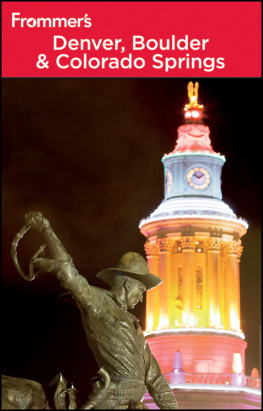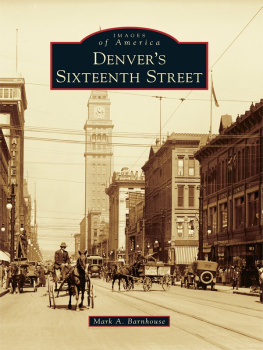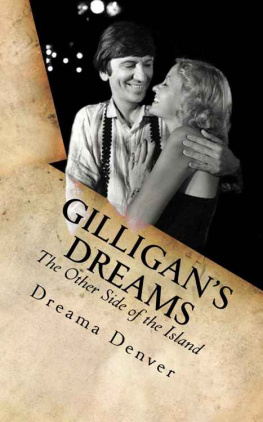JOHN DENVER
Mother Natures Son
John Collis
This eBook is copyright material and must not be copied, reproduced, transferred, distributed, leased, licenced or publicly performed or used in any way except as specifically permitted in writing by the publishers, as allowed under the terms and conditions under which it was purchased or as strictly permitted by applicable copyright law. Any unauthorised distribution or use of this text may be a direct infringement of the authors and publishers rights and those responsible may be liable in law accordingly.
Epub ISBN: 9781780573304
Version 1.0
www.mainstreampublishing.com
Copyright John Collis, 1999
All rights reserved
The moral right of the author has been asserted
First published in Great Britain in 1999 by
MAINSTREAM PUBLISHING COMPANY (EDINBURGH) LTD
7 Albany Street
Edinburgh EH1 3UG
ISBN 1 84018 779 4
This edition, 2003
No part of this book may be reproduced or transmitted in any form or by any means without written permission from the publisher, except by a reviewer who wishes to quote brief passages in connection with a review written for insertion in a magazine, newspaper or broadcast
A catalogue record for this book is available from the British Library
ONE
12 October 1997
As someone who had been twice arrested for drunken driving, John Denver could possibly have been flying illegally when he died. On the first occasion, following his arrest on 21 August 1993, he had plea bargained no contest to a lesser charge. He was given probation, and was ordered to play a benefit concert for an organisation who were trying to combat drink-driving by providing the alternative of a free local taxi service.
A year later he crashed his Porsche into a tree near his home in the mountain resort of Aspen, Colorado. It was the night of the final hearing for his second divorce, from Cassandra. After this second drink-driving episode the jury was split. A date for a new hearing was set, and meantime Denver remained in a legal limbo.
Normally someone in this situation would have had his aviation medical certificate revoked pending the trial, and possession of a valid certificate is necessary for a pilots licence to remain in force. However, Denver had not voluntarily surrendered the document, and so it could perhaps be assumed that he was flying while pending an appeal, even if one had not been formally lodged. A source at the Federal Aviation Authority explained: Short of an emergency revocation, the pilot always has due process to challenge the surrender request and a formal revocation if one comes. In this case, no formal official action followed. He was still legal when he flew and he most likely knew it. So do we.
However, this begs the question as to why the FAA failed to pursue Denver to surrender his licence. And it is in direct contradiction of a further newspaper report that the FAA had disqualified Denver from holding a certificate in March 1997, having learned that he had violated a previous instruction to abstain from alcohol as a condition of flying.
His legal right to be in the air was also challenged by a spokesman for the National Transportation Safety Board, charged with investigating the fatal accident. This source claimed that he had been deprived of the authority to fly in June 1996, when the required medical certificate was withheld on account of the first drink-driving incident.
This is clearly a murky area but also a very important one, given its bearing on such matters as insurance. And also, of course, on the reputation of the squeaky-clean singer: it may well have been a wife-beating drunk who fell into the ocean, a man not so spotless after all. This is not to speak ill of the dead just the opposite, in fact. Denver was clearly a far more complex, and therefore interesting, person than the straightforward surface of his music at first suggests.
The plane was an experimental, fibreglass two-seater, a Long EZ built from a kit, and Denver had just taken delivery of it from another pilot. He took off from Monterey Airport at five oclock in the afternoon, local time, and headed out towards the ocean to practise take-off and landing procedures. He made three attempts to relay his position to the control tower, and his last words were: Do you have it now? At 500 feet, just a hundred yards from the shore, the plane made a popping sound, rose slightly and then fell like a stone. It had been in the air for 27 minutes and, according to one eye witness, it just sort of dropped unexpectedly into the ocean.
This was the second time that Denver had crashed a plane in April 1989 he had crash-landed in a 1931 biplane at an airport in northern Arizona, and climbed out unhurt. In 1995 he was sued by a flying instructor after allegedly taxiing his plane erratically on the runway of a Wyoming airfield. He was, however, a seasoned flyer a qualified pilot for more than 20 years at the time of his death, and one who had been entrusted with the controls of F-15 fighters. And among his billionaire toys was a Lear jet.
A week after the fatal accident, investigators reported that Denver had simply run out of fuel. Seemingly, he had forgotten to check the tanks before take-off, tried to switch to the emergency tank when he realised that the main one was empty, and then perhaps discovered that there was no reserve supply just before his death. It is a matter for conjecture as to how an experienced pilot, as Denver undoubtedly was, could make such an elementary error, surely an impossible mistake if the basic preflight routine of safety checks had been followed.
Indeed, subsequent reports suggested that, although there were indications that the plane had taken off while low on fuel, this had not caused the crash the more straightforward explanation that Denver had simply lost control of an unfamiliar aircraft was deemed more likely. San Francisco television station KRON-TV admitted that its story of Denver running out of fuel could have been an over-simplification of a local newspaper report.
However, when the National Transportation Safety Board had completed its investigation into the tragedy, as reported in the Aspen Times of 23 June 1998, a design modification was revealed. Blueprints for the plane placed the fuel selector handle, which enables the pilot to switch from one tank to the other, within easy reach between his legs. But the builder of this particular model, Adrian Davis Jr, placed the handle behind the pilots left shoulder so that the fuel lines did not have to enter the cockpit. Ironically a well-intentioned safety measure had simply created another potential danger.
Denver was aware of it, too. On the day of his death he and an airfield technician had tried to lengthen the handle by clamping a pair of pincers to it, to bring it within reach. But this ad hoc measure did not solve the problem, and so it was abandoned. Rather than a handle which was close and easy to use, therefore, Denver would have needed to take his hands off the controls, remove his harness and twist around in his seat to switch from an almost empty tank to a full one. We will never know how he could have toyed with this problem just before he died without thinking to check the fuel situation. Because it does seem that there was no full tank of fuel, either the main supply or on standby. The investigation showed that, with 15 gallons in its tank, the plane under Denvers two-week ownership had made a test flight, travelled down to the Monterey airfield and then taken off on its final brief journey. This would probably have used a little more than 15 gallons, and there was no record of recent refuelling.












